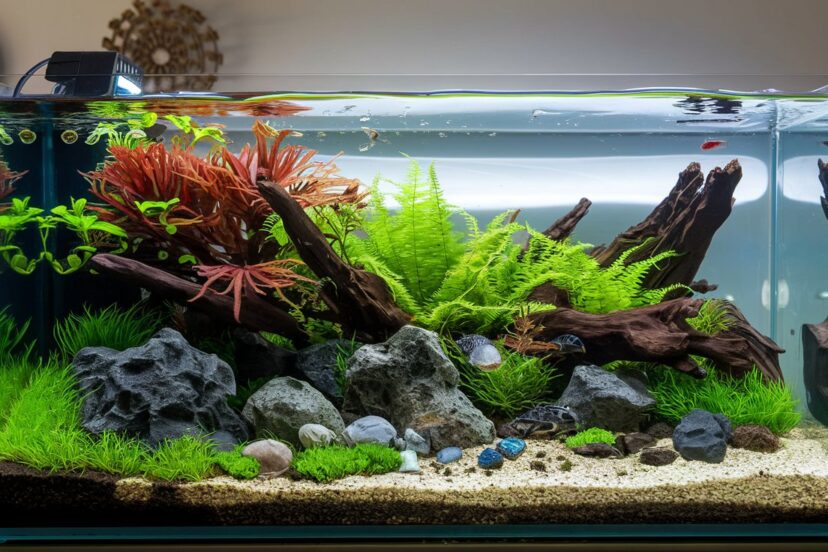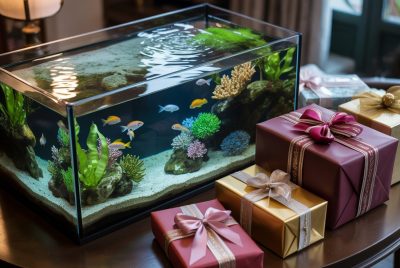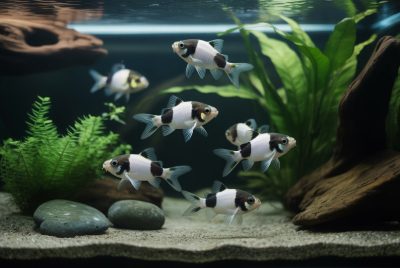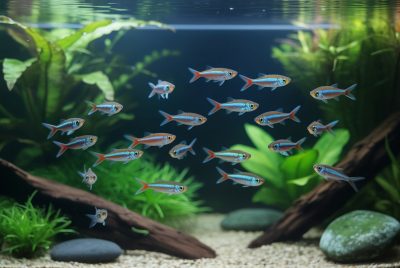Stunning 20 Gallon Aquascape Ideas
*We may earn a commission for purchases made using our links. Please see our disclosure to learn more.
Creating an aquascape in a 20-gallon tank is like painting on the perfect canvas, just the right size to unleash your creativity without feeling overwhelming. Whether you’re looking for 20 gallon aquascape ideas for a vibrant plant display or a calming underwater retreat, these designs can transform your aquarium into a stunning living world.
I’ve spent years perfecting the art of aquascaping these mid-sized tanks, and I’m excited to share ideas that will help you create an aquatic masterpiece in your own home.
Key Takeaways
- 20-gallon tanks provide an ideal balance between creative freedom and manageable maintenance
- The best aquascapes begin with a strong hardscape foundation (rocks, driftwood) before adding plants
- Consider the rule of thirds and focal points when designing your layout
- Plant selection should account for lighting requirements, growth patterns, and the overall style you want
- Regular maintenance is essential to keep your aquascape looking its best over time
“Aquascaping is not just a hobby; it’s an art form that connects us with nature in our own homes. The 20-gallon tank offers the perfect balance of creative possibility and practical management.”
— James Findley, Founder of The Green Machine
Recommended Equipment for 20-Gallon Aquascapes
Before diving into design ideas, let me share some products I personally rely on for 20 gallon aquascape ideas: These essential tools and accessories will help you build a beautiful, thriving aquatic environment with ease. From reliable filtration systems to the best plant substrates, these products ensure your aquascape stays healthy and vibrant.
Fluval Plant 3.0 LED Light
The Fluval Plant 3.0 LED is a high-performance aquarium light designed for planted tanks, offering full-spectrum illumination to enhance plant growth and aquarium aesthetics. With customizable 24-hour light cycles and six unique band waves, this light provides optimal lighting conditions for a thriving aquatic environment. Its extendable mounting brackets ensure easy installation, making it a versatile choice for various tank sizes.
- Customizable Lighting: Features programmable 24-hour cycles, including sunrise, midday, sunset, and night modes.
- Full Spectrum Growth: Six unique band waves promote healthy plant growth and vibrant colors.
- Wide Coverage: 120-degree light dispersion ensures even illumination across the entire tank.
- Premium Price: Higher cost compared to basic aquarium lighting options.
- App-Dependent Controls: Requires a mobile app for full customization, which may not suit all users.
- Limited Waterproofing: Not fully submersible, so care is needed during maintenance.
This programmable LED provides customizable spectrum lighting perfect for growing aquatic plants. Its sleek design and ability to simulate sunrise/sunset cycles make it ideal for serious aquascapers working with 20-gallon tanks.
ADA Aqua Soil Amazonia
ADA’s Aqua Soil Amazonia Ver. 2 is a high-quality substrate designed to promote lush aquatic plant growth. Made from rare Japanese plant-based black soil, it provides essential nutrients and organic components for vibrant, healthy plants. This soil naturally buffers pH and water hardness, creating ideal conditions for aquatic ecosystems. With an included Amazon concentrate supplement, it enhances plant nutrition for a thriving, beautifully planted aquarium.
- Nutrient-Rich: Provides essential elements and organic components for plant growth.
- pH Balancing: Naturally lowers pH and hardness to optimal levels for aquatic plants.
- Ideal Granule Size: Promotes strong root development while maintaining a natural appearance.
- Initial Cloudiness: May cause temporary water cloudiness until settled.
- Nutrient Depletion: Requires supplementation over time as nutrients are absorbed.
- Higher Cost: More expensive than basic aquarium substrates.
This nutrient-rich substrate promotes healthy plant growth and helps maintain stable water parameters. I’ve found it particularly effective for carpeting plants and delicate stem varieties.
Seachem Flourish Excel
Seachem's Flourish Excel presents a 2-liter liquid solution designed for the planted aquarium, weighing 3.8 pounds. Functioning as an organic carbon source, it serves as a bioavailable supplement for aquatic plants. Flourish Excel contains a photosynthetic intermediate that provides an alternative source of carbon for plants, allowing for its use either in combination with or in the absence of CO2 injection systems.
- Enhanced Plant Growth: Provides organic carbon to support healthy growth and development of aquatic plants in a planted aquarium.
- Versatile Usage: Can be used independently or in conjunction with CO2 injection systems, offering flexibility in carbon supplementation.
- Bioavailable Form: The organic carbon content in Flourish Excel is readily accessible for plant uptake, aiding in their vitality.
- Potential Limitation: While beneficial, its effectiveness might not replicate the impact of a dedicated CO2 injection system for certain high-demand plant species.
- Continuous Use Requirement: Regular dosing is necessary to maintain optimal carbon levels for consistent plant growth, potentially requiring frequent application.
- Potential Algae Impact: Overdosing or improper use might lead to algae issues, necessitating careful dosage and monitoring.
An excellent liquid carbon supplement that helps boost plant growth without the complexity of a CO2 system. It’s perfect for moderate-light 20-gallon setups where a full CO2 system might be overkill.
Eheim Classic External Canister Filter
The EHEIM Classic 2215 External Canister Filter is designed for aquariums up to 92 US gallons, providing reliable filtration for a cleaner, healthier tank environment. With easy maintenance features such as a permo-elastic silicon sealing ring and included filter media, it ensures top-notch performance. The package includes essential accessories like a spray bar, inlet pipe, and installation parts, making setup and use a breeze. Perfect for aquarists seeking efficient and quiet filtration.
- Easy Maintenance: Silicon sealing ring allows for simple, safe closing after cleaning.
- Complete Kit: Comes with all necessary accessories and filter media for hassle-free setup.
- Quiet Operation: Designed for smooth, quiet filtration, ideal for home or office use.
- Size: May be too large for smaller aquariums.
- Price: Higher upfront cost compared to some other filters.
- Flow Rate Adjustment: May require additional accessories for precise flow control.
Silent, reliable, and efficient, this filter provides excellent mechanical and biological filtration while remaining compact enough for a 20-gallon setup. I’ve had mine running for years without issues.
Inspiring 20-Gallon Aquascape Ideas
1. Iwagumi Style: Minimalist Rock Garden
The Iwagumi style focuses on rock arrangements following traditional Japanese principles. In a 20-gallon tank, I typically use 3-5 stones of varying sizes, with one dominant “oyaishi” (main stone) as the focal point.
For plants, I keep it simple with carpeting species like Dwarf Hairgrass (Eleocharis acicularis) or Monte Carlo (Micranthemum tweediei). The key is creating negative space, resist the urge to overcrowd. I’ve found that Seiryu stones work beautifully in this style, creating dramatic landscapes despite the tank’s modest size.
The 20-gallon long format (30″ × 12″ × 12″) works particularly well for Iwagumi, as the horizontal orientation mimics natural landscapes more effectively. Consider adding a school of 10-12 small fish like Ember Tetras or Green Neon Tetras to complete the scene.
2. Nature Aquarium: Balanced Harmony
The Nature Aquarium style, pioneered by Takashi Amano, seeks to replicate natural ecosystems in miniature. For a 20-gallon version, I start with driftwood pieces (spider wood or Malaysian driftwood work well) and create triangular or island layouts.
I like to use a variety of plant textures: background stems like Rotala rotundifolia, midground plants like Anubias nana, and foreground carpets of Glossostigma elatinoides. The secret to success with this style is layering—creating depth through careful placement of materials and plants of different heights.
Fish selection should complement your design. I’ve had great success with small schooling fish like Harlequin Rasboras combined with a centerpiece species such as a Dwarf Gourami. Shrimp are excellent additions as they help with maintenance while adding life to the lower levels.
3. Dutch Aquascape: The Underwater Garden
The Dutch style emphasizes lush plant growth with minimal hardscape. In a 20-gallon tank, I’ve found success creating distinct plant “streets” running front to back, using contrasting leaf shapes and colors.
For this style, I recommend using stem plants like Ludwigia repens, Bacopa caroliniana, and Rotala wallichii arranged in groups. The key is regular pruning to maintain the distinct boundaries between plant groups. A nutrient-rich substrate and good CO2 injection are essential for this plant-heavy approach.
The challenge with Dutch styles in 20-gallon tanks is maintenance, stem plants grow quickly and require weekly trimming. However, the vibrant colors and structured appearance make it worth the effort. I find that peaceful community fish like Pristella Tetras complement this style beautifully.
4. Jungle Style: Controlled Chaos
The Jungle style is perfect for those who love lush, wild-looking tanks but don’t want to commit to the strict maintenance of Dutch aquascapes. In my 20-gallon jungle tanks, I use twisted driftwood pieces and attach epiphytes like Java Fern, Anubias, and various Bucephalandra species.
Unlike other styles, the jungle aquascape becomes more beautiful as it grows in, with plants intertwining and creating natural compositions. I avoid rigid placement and instead let plants find their own space, occasionally guiding their growth with strategic pruning.
This style works well with fish that appreciate densely planted environments, such as Apistogramma species or Kuhli Loaches. The abundant hiding places make it ideal for shy species, while the plant mass helps maintain excellent water quality.
5. Biotope Aquarium: Authentic Habitats
A biotope aquascape recreates a specific natural habitat with geographically accurate materials and species. For a 20-gallon tank, I’ve had success with Amazon blackwater biotopes and Southeast Asian stream environments.
For an Amazon blackwater setup, I use bogwood, leaf litter, and minimal plants like Amazon Swords or Anubias. The water is tinted with botanicals like catappa leaves, creating the characteristic tea color. Cardinal Tetras and a pair of Bolivian Rams make excellent inhabitants for this authentic recreation.
In contrast, a Southeast Asian stream biotope uses rounded river stones, light-colored sand, and plants like Cryptocoryne species. Celestial Pearl Danios or Vietnamese White Cloud Mountain Minnows are perfect for this setting.
6. Paludarium: Land and Water
While challenging in smaller tanks, a 20-gallon high tank (24″ tall) can accommodate a simple paludarium design. I’ve created these by using egg crate and foam to build an elevated area that emerges from the water.
Terrestrial plants like Pothos, Peace Lilies, and various mosses can grow above water, while aquatic plants occupy the submerged area. Adding a small waterfall feature creates visual interest and improves oxygenation. This setup works well with amphibious creatures like freshwater shrimp, small fish in the water section, and perhaps a small tree frog in the terrestrial area (with appropriate research and care).
7. Island/Diorama Style: Creating Miniature Worlds
The Island or Diorama style creates the illusion of a complete world within your tank. In my 20-gallon versions, I use central hardscape elements to create an “island” surrounded by negative space (open substrate).
I typically build height using lava rock as a base, covered with mesh and substrate, then planted with mosses and small plants. Spider wood branches extending from the island create dramatic silhouettes, especially when adorned with mosses or small Anubias.
This style works particularly well with carpet plants extending from the island into the surrounding “beach” areas. For fish, I recommend species that will swim in open water around the island, like Celestial Pearl Danios or Chili Rasboras.
Practical Tips for 20-Gallon Aquascapes
Lighting Considerations
For a 20-gallon tank, lighting is crucial yet manageable. I recommend LEDs that provide 30-50 PAR (Photosynthetically Active Radiation) at the substrate level for low-tech setups, or 50-80 PAR for high-tech tanks with CO2 injection.
When considering 20 gallon aquascape ideas, the tank’s height affects light penetration, so a 20-gallon high (24″ tall) requires stronger lighting than a 20-gallon long (12″ tall). I’ve found that most modern LED fixtures designed for planted tanks work well, but avoid budget options that lack adjustable intensity.
Filtration Balance
Finding the right balance between water movement and filtration is tricky in smaller tanks. For 20-gallon aquascapes, I prefer filters rated for 80-100 gallons per hour, but with adjustable flow rates. This provides sufficient biological filtration without creating a hurricane in your tank.
Canister filters work best for serious aquascaping as they’re hidden outside the tank, maintaining the aesthetic integrity of your design. HOB (Hang-On-Back) filters can work but may disrupt the visual experience.
CO2 Injection Options
While not strictly necessary for all 20-gallon aquascapes, CO2 injection dramatically improves plant growth and health. For this tank size, I recommend either:
- A pressurized system with a 5lb cylinder, dual-stage regulator, and in-line diffuser (for serious enthusiasts)
- A mini pressurized system like the Fluval Mini CO2 kit (for intermediate aquascapers)
- DIY yeast-based CO2 (for beginners, though results vary)
If you’re not ready for CO2 injection, focus on low-light plants like Anubias, Java Fern, Cryptocoryne, and various mosses.
Maintenance Schedule
A 20-gallon tank strikes a good balance between stability and maintenance requirements. My typical maintenance schedule for 20 gallon aquascape ideas includes:
- Weekly: 25-30% water change, glass cleaning, minor pruning
- Biweekly: Filter cleaning, more substantial plant trimming
- Monthly: Root tab fertilizer replenishment (if used)
- Quarterly: Deep substrate cleaning in open areas, filter media replacement
Set aside about 30-45 minutes weekly for routine maintenance. This investment pays off in a thriving, beautiful aquascape.
Common Challenges and Solutions
Algae Management
Algae can be particularly frustrating in display aquascapes. In my experience with 20-gallon tanks, prevention is key:
- Maintain a consistent 8-hour photoperiod
- Ensure nutrient balance (particularly nitrogen and phosphate)
- Include fast-growing plants during the tank’s early stages
- Consider algae-eating creatures like Amano shrimp, Otocinclus catfish, or Nerite snails
If algae does appear, identify the type before taking action. Green spot algae requires different treatment than hair algae or black beard algae.
Plant Health Issues
Plant melting or poor growth in 20-gallon tanks often stems from transition shock or nutrient deficiencies. I recommend:
- Starting with healthy specimens from reputable sources
- Using root tabs for heavy root feeders like Cryptocoryne or Amazon Swords
- Implementing a consistent liquid fertilization regimen
- Ensuring your substrate supports the plants you’ve chosen
Remember that some plant species (Cryptocoryne in particular) typically melt when first introduced but will regrow adapted to your water parameters.
Conclusion
The 20-gallon aquarium offers the perfect balance for creative aquascaping, enough space to implement complex designs while remaining manageable for both beginners and experienced hobbyists. Throughout my years in the hobby, I’ve found that these mid-sized tanks consistently deliver the most satisfaction per gallon.
Whether you choose the minimalist beauty of Iwagumi, the lush growth of a Dutch aquascape, or the authentic recreation of a natural biotope, your 20 gallon aquascape ideas can become a stunning underwater landscape that brings nature’s beauty into your home.
Remember that successful aquascaping combines technical knowledge with artistic vision. Start with a clear concept, invest in quality equipment, choose appropriate plants, and commit to regular maintenance. With patience and care, your 20-gallon aquascape will evolve into a living masterpiece.
Frequently Asked Questions
1. How much substrate do I need for a 20-gallon aquascape?
For a standard 20-gallon tank, I recommend using 15-20 pounds of aquarium substrate. For planted tanks, aim for a depth of 2-3 inches in the front sloping to 3-4 inches in the back. This creates depth perception while providing adequate rooting space for plants.
2. How many fish can I keep in a planted 20-gallon aquascape?
Follow the inch-per-gallon rule with caution. In a well-maintained planted 20-gallon tank, I’d recommend no more than 15-20 inches of fish total. This might mean 10-15 small tetras or 6-8 slightly larger fish like small rainbowfish. Remember that a heavily planted tank can support slightly more fish due to the plants’ filtration benefits.
3. Do I need CO2 injection for a successful 20-gallon aquascape?
While not mandatory, CO2 injection significantly expands your plant options and enhances growth. I’ve created beautiful 20-gallon aquascapes both with and without CO2. If you choose to skip CO2, focus on undemanding plants like Anubias, Java Fern, Bucephalandra, and Cryptocoryne species, and accept slower growth rates.
4. How often should I perform water changes on my 20-gallon planted tank?
For established 20-gallon planted aquascapes, I recommend weekly water changes of 25-30%. Even in heavily planted tanks with seemingly stable parameters, regular water changes prevent the accumulation of dissolved organic compounds and replenish minerals. During the first few months, more frequent changes (twice weekly) help manage ammonia spikes.
5. What’s the best tank orientation for a 20-gallon aquascape?
Both standard and “long” 20-gallon configurations work well for aquascaping, but serve different purposes. The 20-gallon long (30″ × 12″ × 12″) offers more front-to-back depth and works beautifully for landscape-oriented designs like Iwagumi or Nature Aquarium styles. The standard 20-gallon (24″ × 12″ × 16″) provides more vertical space, making it ideal for Dutch styles or designs featuring tall hardscape elements.














